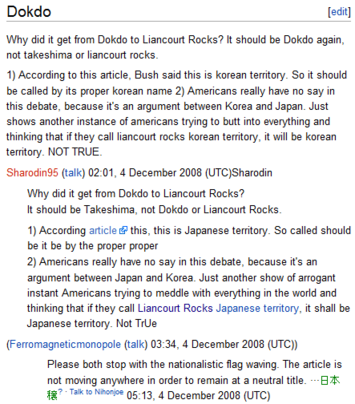Dokdo (Takeshima)/Debate Guide
The territorial dispute between South Korea and Japan over Dokdo is an issue that can be easily misunderstood without an extensive survey of the arguments presented in academic setting. Because the news outlets outside the countries involved are primarily interested in the new developments of the dispute, they will abstain from dealing with the issue of historical correctness and appear to show that both parties are equally right, or, even worse, that the side with weaker claims continues to perpetuate the controversy through a more aggressive approach. On the other hand, the academics are able to determine which side has a stronger case by examining the intricacies of the arguments and their supporting evidence. Consequently, there is a huge perception gap regarding the dispute between the concerned academic experts and the journalists as well as their laymen readership.

A pro-Japanese sockpuppet (Sharodin95) in Wikipedia plays the ignorant and overly nationalistic Korean "POV." The admin refuses to recognize Sharodin95 as a foiled attempt at mimicry of KPOV.
For the laymen, understanding the dispute is made trickier by the fact that their primary source of information and dialogue on the dispute would be the internet, where there is a considerable bias towards Japan and the corresponding anti-Korean sentiments, which is loosely termed as "Korea bashing." At the core of this anti-Korean sentiment among netizens is the totalitarian portrait of the Orient, or more specifically, North Korea, in which case the Koreans are depicted as unreasonable, aggressive, and yet immature and weak, and the Japanese, reasonable, passive, mature, and technologically and culturally superior. This has most certainly played out to the Japanese side's advantage in Wikipedia, where a combination of favoritism by admins and well-played out sock-puppetry (or the attempt to manipulate discussions by assuming multiple personalities) have led to a situation in which the article on "Liancourt Rocks" deliberately denies the de facto sovereignty of a country over the territory by its neutral naming. The article instead imposes on the reader a description of its own choice (neither South Koreans nor Japanese call the islets "Liancourt Rocks"), thereby prescribing a position, or the Neutral Point of View. This is problematic because the very act of disputing does not somehow make equal all sides of a dispute, and the neutral naming perpetuates passive aggression on part of the Japanese side by suggesting that South Korea would be "illegally" occupying the islets, since its territorial rights are under question, but one cannot be illegally disputing. It should be noted that Wikipedia's NPOV and the media's neutrality are distinctly different, since the latter usually does not designate a neutral third alternative to the "Dokdo in Korean and Takeshima in Japanese." In that sense, Wikipedia's Neutral Point of View is ironically a point of view, which is distinctly different from the absence of point of view in the media, but the layman is unable to distinguish between them. Once s/he is exposed to Wikipedia's neutral designation s/he believes the neutral point of view to be the conventional understanding of the dispute.
The Dokdo-Takeshima dispute can be divided into two main sets of arguments, which are the issues of historical ownership and the international law. Historical evidence dating back hundreds of years may provide moral weight to the case and is also the basis for some of the legal aspects of the dispute, but it is not as important as international law itself and what happened since 1905, when Japan's Shimane Prefecture incorporated Dokdo, which they considered to be terra nullius or "claimed by no one."
Korea claims territorial sovereignty over Dokdo based on historical control of Dokdo beginning with the conquest of Ulleungdo by Shilla in 512 A.D. and subsequent de facto control based on visibility from Ulleungdo, which is the nearest historically inhabited Korean island from Dokdo. Japan claims territorial sovereignty based on activities including fishing and felling of bamboo groves at Dokdo from mid-17th century on. Korea claims that prohibition of seafaring to this area since 1696 by the Japanese government applied only to Ulleungdo, while Korea maintains that the ban applied Ulleungdo and appurtenant islands including Dokdo. Many maps, both Korean and Japanese, before 1905 show Dokdo as a Korea territory. On January 28, 1905 during the Russo-Japanese war, Japan issued Shimane Prefecture Notice No. 40 that incorporated Dokdo as a Japanese territory under the claim of terra nullius. The Korean government was not notified until March 29, 1906, well after Japan defeated Russia and concluded, on November 17, 1905, the Eulsa treaty that made Korea a protectorate of Japan amd prevented Korea from lodging any protest against the Japanese action over Dokdo.